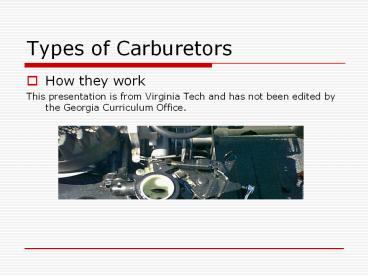Types%20of%20Carburetors - PowerPoint PPT Presentation
Title:
Types%20of%20Carburetors
Description:
Types of Carburetors How they work This presentation is from Virginia Tech and has not been edited by the Georgia Curriculum Office. – PowerPoint PPT presentation
Number of Views:454
Avg rating:3.0/5.0
Title: Types%20of%20Carburetors
1
Types of Carburetors
- How they work
- This presentation is from Virginia Tech and has
not been edited by the Georgia Curriculum Office.
2
Performance Objectives
- Students will be able to list and describe the
common types of small engine carburetors and
their applications.
3
Enabling Objectives
- Given the instruction in class the student will
correctly identify and describe the principles of
operation of the three common types of small
engine carburetors. - Natural or side draft
- Updraft
- Downdraft
4
Interest Approach
- How many of you know where the carburetor is
located on your lawn mower? - Is it above or below the gas tank?
- Does it really matter where it is located in
relation to how it works?
5
Types of Carburetors
- In this unit we will discuss three common types
of carburetors. They are the - Natural or side draft
- Updraft
- Downdraft
6
Natural Draft Carburetor
- This carburetor is used where there is little
space on top of the engine. The air horizontally
into the manifold.
7
Updraft Carburetors
- This type is placed low on the engine and use a
gravity fed-fuel supply. In other words, the
tank is above the carburetor and the fuel falls
to it.
8
Updraft Carburetors
- Even this carburetor uses gravity to receive the
fuel from the tank, the air-fuel mixture must be
forced upward into the engine.
9
Downdraft Carburetors
- This carburetor operates with lower air
velocities and larger passages. This is because
gravity assists the air-fuel mixture flow to the
cylinder.
10
Down-draft Carburetors
- The downdraft carburetor can provide large
volumes of fuel when needed for high speed and
high power output.
11
Float-Type Carburetor
- A Float is a small sealed vessel made of brass or
plastic. It maintains a constant level of fuel
in the float bowl.
12
Float-Type Carburetors
- The float works much like one in a watering
system, opening and closing a needle valve as the
float lowers or raises.
13
The Choke
- The choke is a round disc mounted on a shaft
located at the intake end of the carburetor.
14
The Choke
- Since cold fuel is hard to vaporize, the choke is
used during cold engine starts to provide a rich
mixture to the carburetor in order to get the
engine started.
15
The Throttle
- The throttle is a round disc mounted on a shaft
beyond the main fuel nozzle in the carburetor.
16
The Throttle
- It regulates the amount of air-fuel mixture
entering the cylinder.
17
Load Adjustment
- The amount of fuel entering the main discharge
nozzle is sometimes regulated by a load adjusting
needle.
18
Load Adjustment
- Many carburetors today have a fixed jet or
orifice which is preset to allow the proper
amount of flow. These carburetors are
non-adjustable.
19
The Primer
- Many small engines have hand operated plunger
called a primer. When depressed it forces
additional fuel through the main nozzle prior to
starting a cold engine.
20
Diaphragm Carburetors
- This type does not have a float, rather the
difference between atmospheric pressure and the
vacuum created in the engine pulsates a flexible
diaphragm.
21
Diaphragm Carburetors
- The pulsation of the diaphragm takes place on
every intake and compression stroke.
22
Throttle Controls
- A basic manual throttle control consists of
either mechanical linkage or flexible cable.
23
Throttle Controls
- This linkage manually opens and closes the
throttle valve to obtain the desired engine
speed.
24
Summary
- Small engines have one of the following types of
carburetors - Natural or side draft
- Updraft
- Downdraft
25
Summary
- The natural or side draft carburetor is used when
there is little space on top of the engine. The
air flows horizontally into the manifold.
26
Summary
- The updraft carburetor is place low on the engine
and uses a gravity fed fuel supply. - The air-fuel mixture is forced upward into the
engine.
27
Summary
- The downdraft carburetor operates with lower air
velocities and larger passages. - It provides larger volumes of fuel when needed.
28
Summary
- Some carburetors are either float type or
diaphragm carburetors. - The float type uses a float to maintain a
constant level of fuel in the fuel bowl - The diaphragm carburetor uses differences in
atmospheric pressure and vacuum pressure to
pulsate a diaphragm to pump fuel.































